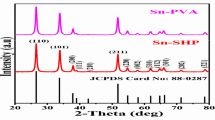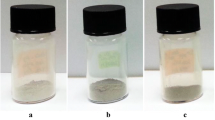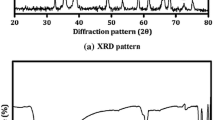Abstract
The effects of copper nanoparticles (CuNP) dispersion on the optical and electrical properties of mesoporous SBA-15 like silica were investigated. Full characterization of the resulting SBA-15-Cu through X-ray diffraction (XRD), thermogravimetry analysis (TGA), scanning electron microscopy (SEM), energy dispersion X-ray fluorescence (ED-XRF), diffuse reflectance (DRS) and Fourier Transform Infrared spectroscopy (FT-IR) revealed marked changes in the structure properties after copper incorporation. Slight decrease in the optical band gap energy in the SBA-15-Cu was also noticed. The shifts towards higher wavelengths are attributed to change in the acceptor capacity level induced by iron nanoparticles. Measurements of Z' and Z" in temperature showed an improvement in proton mobility of SBA-15-Cu. Deeper insights in the capacitance and conductance by impedance spectroscopy measurements over a wide range of frequencies at various temperatures suggest that CuNPs interaction with SBA-15 surface and silanol deprotonation can be, at least partly, responsible for conductance improvement. The above properties make these materials to be regarded as efficient materials for potential applications in electronics.











Similar content being viewed by others
References
P.L. Freund, M. Spiro, Colloidal catalysis: the effect of sol size and concentration. The Journal of Physical Chemistry 89(7), 1074–1077 (1985)
E. Grabowska et al., Modification of titanium (IV) dioxide with small silver nanoparticles: application in photocatalysis. The Journal of Physical Chemistry C 117(4), 1955–1962 (2013)
M.N. Morshed et al., Titania-loaded cellulose-based functional hybrid nanomaterial for photocatalytic degradation of toxic aromatic dye in water. Journal of Water Process Engineering 33, 101062 (2020)
C.L. Haynes, R.P. Van Duyne, Dichroic optical properties of extended nanostructures fabricated using angle-resolved nanosphere lithography. Nano Lett. 3(7), 939–943 (2003)
A.J. Haes et al., A nanoscale optical biosensor: the long range distance dependence of the localized surface plasmon resonance of noble metal nanoparticles. J. Phys. Chem. B 108(1), 109–116 (2004)
V.P. Zharov et al., Photothermal nanotherapeutics and nanodiagnostics for selective killing of bacteria targeted with gold nanoparticles. Biophys. J. 90(2), 619–627 (2006)
T. Textor, M.M.G. Fouda, B. Mahltig, Deposition of durable thin silver layers onto polyamides employing a heterogeneous Tollens’ reaction. Appl. Surf. Sci. 256(8), 2337–2342 (2010)
B. Nabil et al., Development of new multifunctional filter based nonwovens for organics pollutants reduction and detoxification: High catalytic and antibacterial activities. Chem. Eng. J. 356, 702–716 (2019)
J. Vieillard et al., CuO nanosheets modified with amine and thiol grafting for high catalytic and antibacterial activities. Ind. Eng. Chem. Res. 58(24), 10179–10189 (2019)
A.V. Arus et al., Cu0and Pd0loaded Organo-Bentonites as Sponge-like Matrices for Hydrogen Reversible Capture at Ambient Conditions. ChemistrySelect 1(7), 1452–1461 (2016)
A. Azzouz et al., Metal-inorganic-organic matrices as efficient sorbents for hydrogen storage. Chemsuschem 8(5), 800–803 (2015)
N. Bouazizi et al., Metal-loaded polyol-montmorillonite with improved affinity towards hydrogen. J. Energy Inst. 91(1), 110–119 (2018)
N. Bouazizi et al., Synthesis and properties of ZnO-HMD@ZnO-Fe/Cu core-shell as advanced material for hydrogen storage. J Colloid Interface Sci 491, 89–97 (2017)
N. Bouazizi et al., Cu0-loaded SBA-15@ZnO with improved electrical properties and affinity towards hydrogen. Appl. Surf. Sci. 404, 146–153 (2017)
N. Bouazizi et al., Copper and palladium loaded polyol dendrimer–montmorillonite composites as potential adsorbents for CO2 and H2. J. Mater. Sci.: Mater. Electron. 30(9), 8182–8190 (2019)
N. Bouazizi et al., Properties of SBA-15 modified by iron nanoparticles as potential hydrogen adsorbents and sensors. J. Phys. Chem. Solids 77, 172–177 (2015)
R. Sennour et al., Cu0-Loaded organo-montmorillonite with improved affinity towards hydrogen: an insight into matrix-metal and non-contact hydrogen-metal interactions. Physical Chemistry Chemical Physics 19(43), 29333–29343 (2017)
M.N. Tahir et al., Metal organoclays with compacted structure for truly physical capture of hydrogen. Appl. Surf. Sci. 398, 116–124 (2017)
R. Ouargli-Saker et al., Metal-loaded SBA-16-like silica – Correlation between basicity and affinity towards hydrogen. Appl. Surf. Sci. 411, 476–486 (2017)
M. Aghaei, A.H. Kianfar, M. Dinari, Green synthesis of nanostructure Schiff base complex based on aromatic polyamide and manganese (III) for elimination of Hg (II) and Cd (II) from solutions. J. Iran. Chem. Soc. 16(11), 2489–2500 (2019)
S. Kühl et al., Cu-Based Catalyst Resulting from a Cu, Zn, Al Hydrotalcite-Like Compound: A Microstructural, Thermoanalytical, and InSitu XAS Study. Chemistry A European Journal 20(13), 3782–3792 (2014)
F. Frusteri et al., Multifunctionality of Cu–ZnO–ZrO2/H-ZSM5 catalysts for the one-step CO2-to-DME hydrogenation reaction. Appl. Catal. B 162, 57–65 (2015)
F. Frusteri et al., Stepwise tuning of metal-oxide and acid sites of CuZnZr-MFI hybrid catalysts for the direct DME synthesis by CO2 hydrogenation. Appl. Catal. B 176, 522–531 (2015)
G. Bonura et al., Catalytic features of CuZnZr–zeolite hybrid systems for the direct CO2-to-DME hydrogenation reaction. Catal. Today 277, 48–54 (2016)
G. Bonura et al., DME production by CO2 hydrogenation: Key factors affecting the behaviour of CuZnZr/ferrierite catalysts. Catal. Today 281, 337–344 (2017)
Y. Zhu et al., Construction of Cu/ZrO2/Al2O3 composites for ethanol synthesis: Synergies of ternary sites for cascade reaction. Appl. Catal. B 166, 551–559 (2015)
T. Witoon et al., Effect of hierarchical meso–macroporous alumina-supported copper catalyst for methanol synthesis from CO2 hydrogenation. Energy Convers. Manage. 103, 886–894 (2015)
X. Zhou et al., CuO-Fe2O3-CeO2/HZSM-5 bifunctional catalyst hydrogenated CO2 for enhanced dimethyl ether synthesis. Chem. Eng. Sci. 153, 10–20 (2016)
L. Li et al., Highly selective hydrogenation of CO2 to methanol over CuO–ZnO–ZrO2 catalysts prepared by a surfactant-assisted co-precipitation method. J. Power Sources 279, 394–404 (2015)
H. Yang et al., Core–shell structured Cu@ m-SiO2 and Cu/ZnO@ m-SiO2 catalysts for methanol synthesis from CO2 hydrogenation. Catal. Commun. 84, 56–60 (2016)
P. Gao et al., Fluorinated Cu/Zn/Al/Zr hydrotalcites derived nanocatalysts for CO2 hydrogenation to methanol. J CO2 Util. 16, 32–41 (2016)
K. Omri et al., The optoelectronic properties and role of Cu concentration on the structural and electrical properties of Cu doped ZnO nanoparticles. Phys. B 537, 167–175 (2018)
N. Bouazizi et al., Cu0-loaded SBA-15@ ZnO with improved electrical properties and affinity towards hydrogen. Appl. Surf. Sci. 404, 146–153 (2017)
R. Ouargli et al., SBA-15-supported iron nanoparticles with improved optical properties, conductance and capacitance. Chem. Phys. Lett. 673, 30–37 (2017)
Y. Zhao et al., Catalytic cracking of polypropylene by using Fe-SBA-15 synthesized in an acid-free medium for production of light hydrocarbon oils. J. Anal. Appl. Pyrol. 146, 104755 (2020)
Z. Zhang et al., Pd and Pt nanoparticles supported on the mesoporous silica molecular sieve SBA-15 with enhanced activity and stability in catalytic bromate reduction. Chem. Eng. J. 344, 114–123 (2018)
D. Zhao et al., Triblock copolymer syntheses of mesoporous silica with periodic 50 to 300 angstrom pores. Science 279(5350), 548–552 (1998)
M.M. Araujo et al., Anatase TiO2 nanocrystals anchored at inside of SBA-15 mesopores and their optical behavior. Appl. Surf. Sci. 389, 1137–1147 (2016)
H. El-Desoky, M. Abdel-Galeil, A. Khalifa, Mesoporous SiO2 (SBA-15) modified graphite electrode as highly sensitive sensor for ultra trace level determination of Dapoxetine hydrochloride drug in human plasma. J. Electroanal. Chem. 846, 113157 (2019)
R. Ouargli-Saker et al., Metal-loaded SBA-16-like silica–Correlation between basicity and affinity towards hydrogen. Appl. Surf. Sci. 411, 476–486 (2017)
G. Paleti et al., Direct ethanol condensation to diethyl acetal in the vapour phase at atmospheric pressure over CuNP/SBA-15 catalysts. New J. Chem. 43(25), 10003–10011 (2019)
D. Zhao et al., Nonionic triblock and star diblock copolymer and oligomeric surfactant syntheses of highly ordered, hydrothermally stable, mesoporous silica structures. J. Am. Chem. Soc. 120(24), 6024–6036 (1998)
J.S. Beck et al., A new family of mesoporous molecular sieves prepared with liquid crystal templates. J. Am. Chem. Soc. 114(27), 10834–10843 (1992)
A. Hakiki et al., Synthesis and characterization of mesoporous silica SBA-15 functionalized by mono-, di-, and tri-amine and its catalytic behavior towards Michael addition. Mater. Chem. Phys. 212, 415–425 (2018)
M. Sulpizi, M.-P. Gaigeot, M. Sprik, The Silica-Water Interface: How the Silanols Determine the Surface Acidity and Modulate the Water Properties. J. Chem. Theory Comput. 8(3), 1037–1047 (2012)
M. Castellá-Ventura, E. Kassab, Comparative semiempirical and ab initio study of the harmonic vibrational frequencies of aniline—I The ground state. Spectrochim. Acta, Part A 50(1), 69–86 (1994)
A. Jitianu et al., Influence of the silica based matrix on the formation of iron oxide nanoparticles in the Fe 2 O 3–SiO 2 system, obtained by sol–gel method. J. Mater. Chem. 12(5), 1401–1407 (2002)
T.A. Zepeda et al., Synthesis and characterization of P-modified mesoporous CoMo/HMS–Ti catalysts. Microporous Mesoporous Mater. 111(1–3), 493–506 (2008)
J. Ryu, H.-S. Kim, H.T. Hahn, Reactive sintering of copper nanoparticles using intense pulsed light for printed electronics. J. Electron. Mater. 40(1), 42–50 (2011)
Z. Luan et al., Preparation and characterization of (3-aminopropyl) triethoxysilane-modified mesoporous SBA-15 silica molecular sieves. Microporous Mesoporous Mater. 83(1–3), 150–158 (2005)
I. Terrab et al., Assessment of the intrinsic interactions of mesoporous silica with carbon dioxide. Res. Chem. Intermed. 43(7), 3775–3786 (2017)
L. Wang et al., Structure and optical properties of ZnO: V thin films with different doping concentrations. Thin Solid Films 517(13), 3721–3725 (2009)
Rodríguez, J.A. and M. Fernández-García, Synthesis, properties, and applications of oxide nanomaterials. 2007: John Wiley & Sons.
N. Bouazizi et al., Metal-organo-zinc oxide materials: Investigation on the structural, optical and electrical properties. J. Alloy. Compd. 656, 146–153 (2016)
N. Bouazizi, R. Ben slama, B. Chaouachi, S. Ammar, A. Azzouz et al., Synthesis and characterization of SnO2 HMD-Fe materials with improved electric properties and affinity towards hydrogen. Ceram. Int 42, 9413–9418 (2016)
A. Kaushal, D. Kaur, Pulsed laser deposition of transparent ZnO/MgO multilayers. J. Alloy. Compd. 509(2), 200–205 (2011)
K.G. Chandrappa et al., A hybrid electrochemical–thermal method for the preparation of large ZnO nanoparticles. J. Nanopart. Res. 12(7), 2667–2678 (2010)
G. Petrini et al., Deactivation phenomena on Ti-silicalite. Stud Surf Sci Catal. 68, 761–766 (1991)
S. Selvasekarapandian, M. Vijayakumar, The ac impedance spectroscopy studies on LiDyO2. Mater. Chem. Phys. 80(1), 29–33 (2003)
W.A. England et al., Fast proton conduction in inorganic ion-exchange compounds. Solid State Ionics 1(3–4), 231–249 (1980)
C.K. Maiti et al., Electrical characterization of TiO2 gate oxides on strained-Si. Microelectron. Eng. 72(1–4), 253–256 (2004)
K.K. Saini et al., Structural and optical properties of TiO2 thin films derived by sol–gel dip coating process. J. Non-Cryst. Solids 353(24–25), 2469–2473 (2007)
N. Agmon, The grotthuss mechanism. Chem. Phys. Lett. 244(5–6), 456–462 (1995)
A.K. Jonscher, The ‘universal’dielectric response. Nature 267(5613), 673–679 (1977)
Author information
Authors and Affiliations
Corresponding author
Ethics declarations
Conflict of interest
The authors declare that they have no conflict of interest.
Additional information
Publisher's Note
Springer Nature remains neutral with regard to jurisdictional claims in published maps and institutional affiliations.
Rights and permissions
About this article
Cite this article
Ouargli-Saker, R., Bouazizi, N., Lassouad, S. et al. Copper-loaded SBA-15 Silica with Improved Electron Mobility-Conductance and Capacitance Properties. J Inorg Organomet Polym 30, 5108–5117 (2020). https://doi.org/10.1007/s10904-020-01642-2
Received:
Accepted:
Published:
Issue Date:
DOI: https://doi.org/10.1007/s10904-020-01642-2




